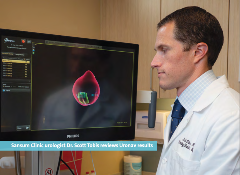
Prostate cancer is one of the most common cancers among men in the United States, with one in every seven men diagnosed in their lifetime. Sansum Clinic urologists and Ridley-Tree Cancer Center oncologists partner on a team approach to offer patients the latest diagnostic tools and treatments for prostate cancer.
Precise prostate cancer diagnostics are critical for treatment planning. Thanks to a generous donation from the Cancer Foundation of Santa Barbara, Sansum Clinic’s Urology Department is now equipped with the UroNav Fusion
Biopsy System, a sophisticated technology which blends pre-biopsy magnetic resonance imaging (MRI) views with ultrasound-guided biopsy images in real time, producing a detailed 3D look at the prostate and any concerning lesions. Sansum Clinic’s board-certified Urology team, which includes Dr. Daniel Curhan, Dr. Ron Golan, Dr. Alex Koper, Dr. Alexandra Rogers and Dr. Scott Tobis, has performed more than 100 of these state-of-the-art biopsies since April of 2020. Procedures have continued during the pandemic with enhanced safety precautions. “Already we have had patients whose cancers would not have been detected without this technique,” explains Dr. Tobis. “It’s changed the course of treatment for the better for those people.” The more complete imaging and subsequent biopsies created using UroNav give patients an added degree of certainty to make critical decisions about their care and treatment.
Treatment options for prostate cancer range from active monitoring for low-risk cancers that don’t require immediate treatment, to minimally-invasive robotic surgery and targeted radiation therapy. For advanced stage prostate cancer, patients have access to hormonal therapies and clinical trials at Ridley-Tree Cancer Center. Determining the virulence of the cancer is a daily challenge for oncologists. “UroNav allows us to see which area of the prostate contains the most worrisome-looking cells, so we can biopsy that specific area. Once we know how favorable or unfavorable the prostate biopsy looks, we can begin to think about which treatment strategy is most appropriate for that specific patient,” remarked Ridley-Tree Cancer Center Oncologist Gregg Newman, MD. Additionally, Dr. Newman notes that when UroNav identifies patients who are considered “low-risk,” treatments known to have more severe side effects can be delayed or even avoided; and similarly, for those with more concerning biopsies, their physicians can focus on more aggressive treatments designed to eliminate the cancer. When urologists, medical oncologists and radiation oncologists have access to the most state-of- the-art equipment to view and biopsy the prostate, patients and their medical teams have the maximum information upon which to make decisions about treatment.